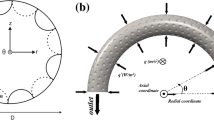Abstract
This study is a numerical investigation of the effect of improving heat transfer namely, modified rough (dimples and protrusions) surfaces on the mixed convective heat transfer of a turbulent flow in a horizontal tube. The effects of different dimples-protrusions arrangements on the improving the thermal performance of a rough tube are investigated at various Richardson numbers. Three dimensional governing equations are discretized by the finite-volume technique. Based on the obtained results the dimples-protrusions arrangements are modified to find a suitable configuration for which heat transfer coefficient and pressure drop to be balanced. Modified dimples-protrusions arrangements that shows higher performance is presented. Its average thermal performance 18% and 11% is higher than the other arrangements. In addition, the results show that roughening a smooth tube is more effective at the higher Richardson number.













Similar content being viewed by others
Abbreviations
- A(m2):
-
Surface of heat transfer
- C1ε,C2ε :
-
constants
- Cp(J/kg. k):
-
Specific heat
- D(m):
-
Tube diameter
- e/D:
-
Dimensionless height of the roughs
- \( f=\frac{\Delta p}{\frac{{\rho V}^2}{2}\left(\frac{L}{D}\right)} \) :
-
Friction factor.
- g(m/s2):
-
Gravitational acceleration
- h(W/m2. K):
-
Heat transfer coefficient
- k:
-
Turbulent kinetic energy
- P/D:
-
Dimensionless pitch of the roughs
- PEC:
-
Performance evaluation criteria
- \( \mathrm{Ri}=\frac{\mathrm{Gr}}{{\operatorname{Re}}^2} \) :
-
Richardson number
- S:
-
User-defined source terms
- T:
-
Temperature
- \( {\mathrm{T}}^{\ast }=\frac{{\mathrm{T}}_{\mathrm{w}}-\mathrm{T}}{{\mathrm{T}}_{\mathrm{w}}-{\mathrm{T}}_{\mathrm{i}}} \) :
-
Normalized temperature
- \( {\mathrm{X}}^{\ast }=\frac{\mathrm{r}}{\mathrm{D}} \) :
-
Normalized radius in direction of horizontal tube diameter
- \( {\mathrm{Y}}^{\ast }=\frac{\mathrm{r}}{\mathrm{D}} \) :
-
Normalized radius in direction of vertical tube diameter
- \( {\mathrm{Z}}^{\ast }=\frac{\mathrm{z}}{\mathrm{D}} \) :
-
Normalized length in axial direction
- α:
-
Thermal diffusivity
- β:
-
Volumetric expansion coefficient (K− 1)
- ε:
-
Dissipation of turbulent kinetic energy
- μ:
-
Dynamic viscosity (Nm s− 2)
- ν :
-
kinematic viscosity of the fluid, (m2/s)
- ρ:
-
fluid density (kg m−3)
- i:
-
Inlet
- b:
-
Bulk
- eff:
-
Effective
- f:
-
Fluid
- fc:
-
Forced convection
- t:
-
Turbulent
- w:
-
Wall
References
Bergles AE (1998) Handbook of heat transfer. McGraw-Hill, New York
Siddique M, Khaled A-R, Abdulhafiz N, Boukhary A (2010) Recent advances in heat transfer enhancements: a review report. Int J Chem Eng, Article ID 106461, p 28
Gee DL, Webb R (1980) Forced convection heat transfer in helically rib-roughened tubes. Int J Heat Mass Transf 23(8):1127–1136
Vicente PG, Garcı́a A, Viedma A (2002) Experimental study of mixed convection and pressure drop in helically dimpled tubes for laminar and transition flow. Int J Heat Mass Transf 45(26):5091–5105
Vicente PG, Garcı́a A, Viedma A (2002) Heat transfer and pressure drop for low Reynolds turbulent flow in helically dimpled tubes. Int J Heat Mass Transf 45(3):543–553
Elyyan MA, Tafti DK (2007) LES investigation of flow and heat transfer in a channel with dimples and protrusions. Power Land, Sea and Air. ASME Turbo Expo GT2007-27811, Montreal
Li R, He YL, Lei YG, Tao YB, Chu P (2009) Numerical study on fluid flow and heat transfer performance of internally roughened tubes with dimples. J Enhanced Heat Transf 16(3):267–285
Chang S, Chiang K, Chou T (2010) Heat transfer and pressure drop in hexagonal ducts with surface dimples. J. Exp Thermal Fluid Sci 34(8):1172–1181
Wang Y, He YL, Lei YG, Zhang J (2010) Heat transfer and hydrodynamics analysis of a novel dimpled tube. J. Exp Thermal Fluid Sci 34(8):1273–1281
Suresh S, Chandrasekar M, Sekhar SC (2011) Experimental studies on heat transfer and friction factor characteristics of CuO/water nanofluid under turbulent flow in a helically dimpled tube. J Experimental Thermal and Fluid Science 35(3):542–549
Garcia A (2012) The influence of artificial roughness shape on heat transfer enhancement: corrugated tubes, dimpled tubes and wire coils. Appl Therm Eng 35:196–201
Lan J, Xie Y, Zhang D (2012) Flow and heat transfer in microchannels with dimples and protrusions. J Heat Transf 134:021901–021901
Kukulka DJ, Smith R (2013) Thermal-hydraulic performance of Vipertex 1EHT enhanced heat transfer tubes. Appl Therm Eng 61(1):60–66
Forooghi P, Hooman K (2013) Effect of buoyancy on turbulent convection heat transfer in corrugated channels–a numerical study. Int J Heat Mass Transf 64:850–862
Li Z, Wu Y, Tang G, Zhang D, Lu J (2015) Comparison between heat transfer to supercritical water in a smooth tube and in an internally ribbed tube. Int J Heat Mass Transf 84:529–541
Li Z, Wu Y, Tang G, Lu J, Wang H (2016) Numerical analysis of buoyancy effect and heat transfer enhancement in flow of supercritical water through internally ribbed tubes. Appl Therm Eng 98:1080–1090
Navaei A, Mohammed HA, Munisamy KM, Yarmand H, Gharehkhani S (2015) Heat transfer enhancement of turbulent nanofluid flow over various types of internally corrugated channels. Powder Technol 286:332–341
Kumar P, Kumar A, Chamoli S (2016) Experimental investigation of heat transfer enhancement and fluid flow characteristics in a protruded surface heat exchanger tube. J. Exp Thermal Fluid Sci 71:42–51
Huang Z, Li ZY, Yu GL, Tao WQ (2017) Numerical investigations on fully-developed mixed turbulent convection in dimpled parabolic trough receiver tubes. Appl Therm Eng 114:1287–1299
Webb R, Kim NH (2005) Principles of enhanced heat transfer. Taylor & Francis, New York
Author information
Authors and Affiliations
Corresponding author
Ethics declarations
Conflict of interest
There is no conflict of interest.
Additional information
Publisher’s Note
Springer Nature remains neutral with regard to jurisdictional claims in published maps and institutional affiliations.
Rights and permissions
About this article
Cite this article
Sobhani, M., Behzadmehr, A. Investigation of thermo-fluid behavior of mixed convection heat transfer of different dimples-protrusions wall patterns to heat transfer enhancement. Heat Mass Transfer 54, 3219–3229 (2018). https://doi.org/10.1007/s00231-018-2356-9
Received:
Accepted:
Published:
Issue Date:
DOI: https://doi.org/10.1007/s00231-018-2356-9




